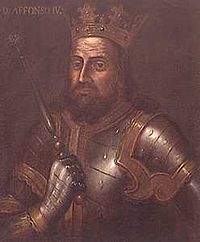Afonso IV
| Afonso IV | ||
|---|---|---|
| King of Portugal and the Algarve | ||

| ||
| Seventeenth century painting of Afonso IV. | ||
| Reign | January 7, 1325 â May 28, 1357 | |
| Full name | Afonso of Portugal | |
| Titles | Infante of Portugal (1291â1325) | |
| Born | February 8, 1291 | |
| Portugal Lisbon, Kingdom of Portugal | ||
| Died | May 28, 1357 | |
| Portugal Lisbon, Kingdom of Portugal | ||
| Buried | Lisbon See Cathedral, Lisbon, District of Lisbon, Portugal | |
| Predecessor | Denis of Portugal | |
| Heir | Infante Pedro (future Peter I) (1325â1357) | |
| Successor | Peter I of Portugal | |
| Consort | Infanta Beatriz of Castile | |
| Issue | Infanta Maria, Queen of Castile (1313â1237) Infante Afonso (1315) Infante Dinis (1317â1318) Infante Pedro (future Peter I) (1320â1367) Infanta Isabel (1324â1326) Infante JoĂŁo (1326â1327) Infanta Leonor, Queen of Aragon (1328â1348) | |
| Royal House | Capetian House of Burgundy | |
| Father | Denis of Portugal | |
| Mother | Elizabeth of Aragon | |
Afonso IV (IPA pron. [É'fĂľsu]) (February 8, 1291 â May 28, 1357), called the Brave (Portuguese: o Bravo), was the seventh from 1325 until his death. He was the only legitimate son of Dinis of Portugal by his wife Elizabeth of Aragon.
| Afonso Henriques (Afonso I) |
|---|
|
| Sancho I |
|
| Afonso II |
|
| Sancho II |
| Afonso III |
|
| Denis |
|
| Afonso IV |
|
| Peter I |
|
| Ferdinand I |
|
| Beatrice (disputed queen) |
|
As king, Afonso IV is remembered as a soldier and a valiant general, hence the nickname, the Brave. But perhaps his most important contribution was the importance he gave to the Portuguese navy. Afonso IV granted public funding to raise a proper commercial fleet and ordered the first maritime explorations. The Canary Islands (today a part of Spain) were discovered during his reign.
Early Life
Afonso, born in Lisbon, was his father's only legitimate son and the rightful heir to the Portuguese throne. However, he was not, according to several sources, Dinis' favorite son; his half-brother, the illegitimate Afonso Sanches, enjoyed full royal favor. From early in life, the notorious rivalry led to several outbreaks of civil war. On January 7, 1325, Afonso's father died and he became king, taking full revenge on his brother. His rival was sentenced to exile in Castile, and stripped of all the lands and fiefdoms donated by their common father. Afonso Sanches, however, did not sit still. From Castile, he orchestrated a series of attempts to usurp the crown for himself. After a few failed attempts at invasion, both brothers signed a peace treaty, arranged by the Afonso's mother Queen Elizabeth.
Kingship
In 1309, Afonso IV married Infanta Beatrice of Castile, daughter of King Sancho IV of Castile by his wife Maria de Molina. The first-born of this union, Infanta Maria of Portugal, married King Alfonso XI of Castile in 1328, at the same time that Afonso IV's heir, Peter I of Portugal, was promised to another Castilian infanta, Constance of Penafiel. These arrangements were imperiled by the ill will of Alfonso XI of Castile, who was, at the time, publicly mistreating his wife. Afonso IV was not happy to see his daughter abused, and started a war against Castile. Peace arrived four years later, with the intervention of Infanta Maria herself. A peace treaty was signed in Seville in 1339 and, in the next year, Portuguese troops played an important role in the victory of the Battle of Rio Salado over the Marinid Moors in October 1340.
The last part of Afonso IV's reign is marked not by open warfare against Castile, but by political intrigue. Civil war between King Pedro of Castile and his half-brother Henry of Trastamara led to the exile of many Castilian nobles to Portugal. These immigrants immediately created a faction among the Portuguese court, aiming at privileges and power that, somehow, could compensate what they lost at home. The faction grew in power, especially after Ines de Castro, daughter of an important nobleman and maid of the Crown Princess Constance, became the lover of her lady's husband: Peter, the heir of Portugal. Afonso IV was displeased with his son's choice of lovers, and hoped that the relationship would be a futile one. Unfortunately for internal politics, it was not. Peter was openly in love with Ines, recognized all the children she bore, and, worst of all, favored the Castilians that surrounded her. Moreover, after his wife's death in 1349, Peter refused the idea of marrying anyone other than Ines herself.
The situation became worse as the years passed and the aging Afonso lost control over his court. Peter's only male heir, future king Fernando of Portugal, was a sickly child, while the illegitimate children sired with Ines thrived. Worried about his legitimate grandson's life, and the growing power of Castile within Portugal's borders, Afonso ordered the murder of Ines de Castro in 1355. He expected his son to give in, but the heir was not able to forgive him for the act. Enraged at the barbaric act, Peter put himself at the head of an army and devastated the country between the Douro and the Minho rivers before he was reconciled to his father in early 1357. Afonso died almost immediately after, in Lisbon in May.
Ancestors
| Afonso IV of Portugal | Father: Denis of Portugal |
Father's father: Afonso III of Portugal |
Father's father's father: Afonso II of Portugal |
| Father's father's mother: Urraca of Castile | |||
| Father's mother: Beatrix of Castile |
Father's mother's father: Alfonso X of Castile | ||
| Father's mother's mother: Maria de GuzmĂĄn | |||
| Mother: Elizabeth of Aragon |
Mother's father: Peter III of Aragon |
Mother's father's father: James I of Aragon | |
| Mother's father's mother: Violant of Hungary | |||
| Mother's mother: Constance of Sicily |
Mother's mother's father: Manfred of Sicily | ||
| Mother's mother's mother: Beatrice of Savoy |
Marriage and descendants
Afonso married Beatrice of Castile (1293-1359) in 1309, daughter of Sancho IV, King of Castile, and Maria de Molia, and had four sons and three daughters.
| Name | Birth | Death | Notes |
|---|---|---|---|
| By Beatrice of Castile (1293-1359; married in 1309) | |||
| Infanta Maria | 1313 | 1357 | Queen of Castile by marriage to Alfonso XI of Castile. |
| Infante Afonso | 1315 | 1315 | Â |
| Infante Dinis (Denis) | 1317 | 1318 | Â |
| Infante Pedro | April 8 1320 | January 18 1367 | Succeeded him as Peter I, eighth King of Portugal. |
| Infanta Isabel | December 21 1324 | July 11 1326 | Â |
| Infante JoĂŁo (John) | September 23 1326 | June 21 1327 | Â |
| Infanta Leonor (Eleanor) | 1328 | 1348 | Queen of Aragon by marriage to Peter IV, King of Aragon. |
| Illegitimate offspring | |||
| Maria Afonso | 1316 | 1384 | Natural daughter. |
ReferencesISBN links support NWE through referral fees
- Garraty, John Arthur, and Peter Gay. A history of the world. New York: Harper & Row, 1972. ISBN 9780060422547
- Levenson, Jay A. The Age of the baroque in Portugal. Washington: National Gallery of Art, 1993. ISBN 9780894681981
- Robertson, Ian. A traveller's history of Portugal. New York: Interlink Books, 2002. ISBN 9781566564403
| House of Burgundy Cadet Branch of the Capetian dynasty Born: 8 February 1291;Â Died: 28 May 1357 | ||
|---|---|---|
|
| ||
| Preceded by: Denis |
King of Portugal and the Algarves 1325 â 1357 |
Succeeded by: Peter I |
| ||||||||||||||||||||
Credits
New World Encyclopedia writers and editors rewrote and completed the Wikipedia article in accordance with New World Encyclopedia standards. This article abides by terms of the Creative Commons CC-by-sa 3.0 License (CC-by-sa), which may be used and disseminated with proper attribution. Credit is due under the terms of this license that can reference both the New World Encyclopedia contributors and the selfless volunteer contributors of the Wikimedia Foundation. To cite this article click here for a list of acceptable citing formats.The history of earlier contributions by wikipedians is accessible to researchers here:
The history of this article since it was imported to New World Encyclopedia:
Note: Some restrictions may apply to use of individual images which are separately licensed.
